-
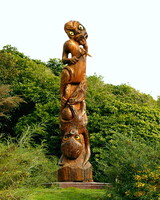
This photograph taken by Sid Mosdell shows an image of a carved pou (post) at Karaka Point in Queen Charlotte Sound, New Zealand. The carving depicts the story of the Māori warrior, Kupe and the monstrous octopus, Te Wheke o Muturangi. Kupe had been struggling to save himself from being drowned, and so he gripped onto the northern end of the island Te Waipounamu (what is now known as the South Island). Eventually, he wins the battle by slicing the octopus in half and forming many of New Zealand's landforms.
-
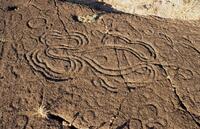
This work, created by an unknown artist, depicts an octopus carved in rock. Located on Easter Island, this carving relates to the Polynesian mythology regarding the creation of the Pacific Islands, which involved their octopus god, Na Kika.
-
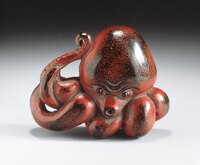
This sculpture by Japanese artist Gyokuzan depicts a red and black octopus. It is from the 19th century and may relate to the Japanese tale of Akkorokamui, a giant octopus in the Uchiura Bay, due to its prominent red color.
-
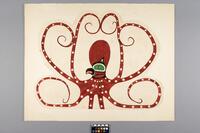
This painting portrays an octopus-like creature with bird-like facial features, painted by Martin Mungo. It resembles Kwakwaka'wakw culture and relates to the story of Kumungwe, the god of the undersea world. Stories of Kumugwe discuss heros coming to his residence, filled of wealth and magic. This is often seen guarded by an octopus, and Kumugwe is sometimes even seen to take on an octopus form himself.
-
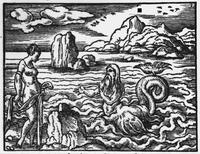
This drawing by Virgil Solis depicts the Greek myth of Scylla and Glaucus, showing the scene of their initial meeting before Scylla is cursed into a wicked sea monster by her adversary, Circe. Prior to being cursed, she was considered to be a beautiful nypmh.
-

This engraving portrays the monumental battle described in the Babyloninian epic Enuma Elish between the goddess of chaos, Tiamat, and the patron god Marduk. The conflict ended with Tiamat's body being split in half, creating the Earth.
-
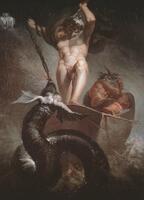
This oil painting by artist Henry Fuseli captures the epic battle of the Norse god of thunder, Thor, battling the great sea serpent Jormungandr- also known as the "Midgard Serpent" or the "World Serpent" for its ginormous size. This painting is a depiction of Thor and Jormungandr's final fight, set during Ragnorok.
-
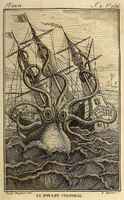
This drawing by French naturalist Pierre Dénys de Montfort portrays a giant octopus with its tentacles wrapped around a ship. Early European narratives of the giant octopus or squid often told tales of these creatures dragging sailors into treacherous waters. Montfort believed that the giant octopus was responsible for the disappearance of British warships in 1782.
-
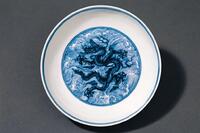
Featured is a blue and white porecelain dish created by an unknown artist. The dish depicts the long, thin, and five-toed dragon typically seen in East Asian artwork, along with storm waves in the background. This decorative theme of the dish means that the porcelain was intended for the imperial family. Many porcelain pieces during the Ming Dynasty, particularly during the reign of Emperors Chenghua and Xuande, depicts dragons in a similar fashion to symbolize their power.
-
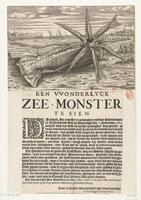
This Dutch newsprint, illustrated by an anonymous artist, portrays a monstrous squid caught by a fisherman in the North Sea on November 12, 1661. According to the newsprint, the squid was embalmed by Professor Johannes van Horne of Leiden University.
-

This engraving, created by Johann Christoph Wagner depicts a ship in the ocean, flanked by various ocean monsters. This is representative of ocean mythology and its attempt to explain humanity's fear and wonder of the ocean.
-
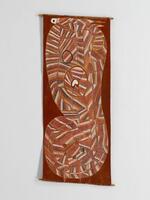
The photograph shows a painting on eucalyptus bark, created by John Mawurndjul. It portrays a horned rainbow snake known as Ngalyod, a hybrid snake with the head of a buffalo. This is a prominent god of the Kuninjku people, an Aboriginal Tribe. The painting was discovered in the Arnhem Land in Australia.
-
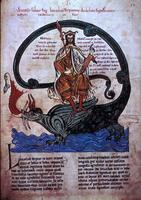
A manuscript by an unknown French artist shows the Antichrist riding the sea serpent, Leviathan. The bookscript is meant to serve as a warning of the ocean, as both of these figures are a representation of chaos.
-
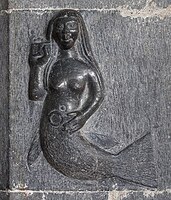
A photograph taken by Andreas F. Borchert of a 15th century mermaid sculpture at a cathedral in Clonfert, Ireland. The sculpture is a reference to the patron of the cathedral, St.Brendan, as in his voyages he was said to have come across a dangerous mermaid who used her seductiveness to put men to sleep. It is a reminder for churchgoers to resist the temptation of sin.
-
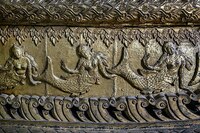
A photograph taken by David Clay of a carved decorative motif of mermaids from the Southeast Asian version of the Ramayana in Wat Xieng Thong, Luang Prabang, Laos. The mermaids are depicted on a cataflaque, or the framework of a coffin of a distinguished individual. This is indicative of their presence as a luck bringing charm in various Southeast Asian cultures.
-
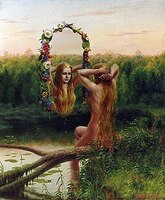
This painting, created by Сергей Панасенко-Михалкин depicts the Rusalka, or an eastern European equivalent to a mermaid. It shows a naked women in a river, looking at her reflection surrounded by a beautiful ring of flowers. It shows the seductiveness of these creatures and the way they are able to lure men into their deaths with their beauty.
-
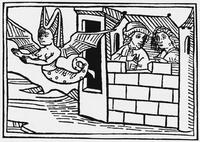
This illustration created by Anonymous Artists is a depiction of Melusine, a creature that resembles a mermaid in European folklore. It was meant to depict the punishment Melusine faced for seeking revenge on her father. She was condemned to this form by her own mother.
-
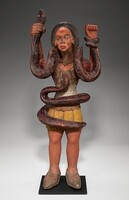
Created by an unknown artist, this sculpture depicts the mythic water spirit, called Mami Wata, meaning "Water as Mother" or "Mother of the Waters." It is depicting her in her tailless form, showing her snake-charming abilities.
-
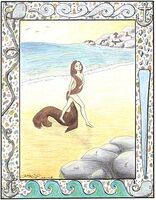
An illustration created Carolyn Emerick depicting a selkie in her human form along the shore of a beach. It shows the allure that selkies often have in Gaelic mythology when they aim to attract and lure men into dangerous situtations.
-
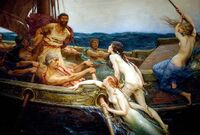
A painting by Herbert James Draper depicting a scene from the Odyssey where Ulysses is being tormented by sirens as he is tied down to the mast of his ship. As the sirens are climbing the boat, they lose their fish-like features and are depicted as nude women using their seductiveness to lure Ulysses into danger.



















